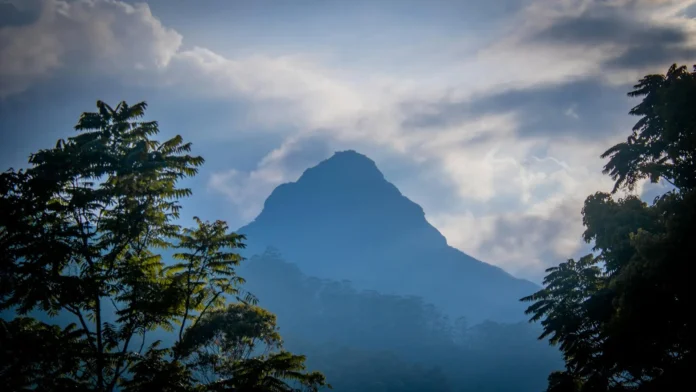“Where Heaven Meets Earth, and All Paths Converge“
Rising in the misty highlands of central Sri Lanka, Sri Pada commonly known as Adam’s Peak stands not only as a towering natural marvel but also as a sacred pilgrimage site revered by people of many faiths. Soaring 2,243 meters (7,359 feet) above sea level, this iconic conical mountain is renowned for the mysterious “sacred footprint” (Sri Pada) a revered rock formation believed to be the footprint of a divine figure. Over the centuries, this mountain has drawn Buddhists, Hindus, Muslims, and Christians, each attributing the footprint to a different religious figure, making Adam’s Peak a powerful symbol of interfaith unity and spiritual reverence.
According to Buddhist tradition, the footprint is that of the Buddha, left during his third legendary visit to Sri Lanka. For Hindus, it is the footprint of Lord Shiva. Muslims and Christians believe it to be that of Adam, who is said to have stepped on the mountain after his expulsion from the Garden of Eden—thus the name “Adam’s Peak.” This convergence of beliefs makes Sri Pada one of the few religious sites in the world shared harmoniously by multiple faiths, each offering its own mythology and rituals.
The pilgrimage season, which traditionally runs from December to May, is a time of vibrant spiritual activity. Pilgrims from across Sri Lanka and beyond ascend the mountain, often beginning their journey at night to reach the summit by dawn. This allows them to witness the breathtaking sunrise—a spectacle of light and shadow where the mountain casts a perfectly triangular shadow over the surrounding plains, creating a moment of awe that is both natural and mystical.
There are several routes to the summit, the most popular being the trail from Nallathanniya, near Hatton. This path features more than 5,000 stone steps, lit by electric lamps and lined with modest tea shops offering refreshments and rest. Though challenging, the climb is part of the spiritual experience. Every step becomes a form of meditation, a small act of devotion echoing the millions who have walked this path over the centuries.
Along the way, pilgrims chant prayers, sing songs, and ring bells to mark the number of times they’ve completed the ascent. Many walk barefoot, some carry offerings of flowers and incense, while others ascend in silence, seeking solitude and reflection. The climb becomes more than a physical effort—it transforms into a journey inward, where fatigue gives way to faith and elevation mirrors enlightenment.
At the summit, a small shrine houses the sacred footprint, protected by a wire enclosure and venerated with flowers, lamps, and incense. The air is crisp and filled with chants and whispers. As the first rays of sun break through the sky, a hush falls over the crowd. For many, this sunrise is a deeply spiritual moment—a reward not just for the body but for the soul. The golden light touching the clouds and peaks evokes a sense of unity, renewal, and peace.
Adam’s Peak is also a biodiversity hotspot, located within the Peak Wilderness Sanctuary, a part of the Central Highlands of Sri Lanka, which is a UNESCO World Heritage Site. The region is home to a wide variety of flora and fauna, including endemic species like the Sri Lankan leopard, purple-faced langur, and numerous orchids. The climb offers glimpses of dense montane forests, cascading waterfalls, and the soothing sounds of birds and insects—a sacred harmony of spirituality and ecology.
Beyond its religious and natural appeal, Sri Pada has deep cultural and historical significance. Ancient chronicles such as the Mahavamsa and foreign travelers like Marco Polo have mentioned the mountain. Inscriptions and ruins along the trail point to centuries of devotion, with kings and emperors supporting the upkeep of the pilgrimage route. Even today, the government and local communities work together to maintain the trails, provide safety, and preserve the mountain’s sanctity.
The spiritual inclusivity of Sri Pada sets it apart. It is one of the few places where devotees from different religions come together to worship in peace. You might see Buddhist monks offering blessings beside Hindu priests performing poojas, while Muslims and Christians silently pray at the footprint. This shared reverence promotes a message that transcends doctrine: the idea that sacredness belongs to all and that the divine can be found in unity, compassion, and nature.
Climbing Adam’s Peak is not reserved for the religious alone. For nature lovers, photographers, hikers, and cultural travelers, it is an unforgettable experience. The rhythmic sound of footsteps, the flickering lamps in the dark, the smiling faces of fellow pilgrims, and the sweeping mountain views all create a memory that lingers long after the descent. Whether you’re seeking spiritual insight, personal growth, or simply beauty, Sri Pada delivers on every level.
Yet, this sacred site also faces challenges. Increasing foot traffic has brought issues of pollution and erosion. Responsible tourism, respectful behavior, and environmental awareness are vital in preserving the mountain for future generations. Pilgrims are encouraged to follow eco-friendly practices: avoid littering, minimize noise, and support local communities who act as guardians of the trail.
For many Sri Lankans, making the pilgrimage to Sri Pada is a rite of passage, often undertaken with family or as a form of penance or thanksgiving. Some climb every year as a vow, others once in a lifetime. No matter how many times it is done, the mountain always feels different—weather, mood, and companions all changing, while the spiritual pull remains constant.
In conclusion, Sri Pada (Adam’s Peak) is not just a mountain—it is a living sanctuary of shared faith, natural beauty, and human endurance. Whether seen from afar or climbed in devotion, it commands respect and invites reflection. It teaches that holiness can be found not just in temples or texts, but also in the rhythm of footsteps, the strength of will, and the light of dawn.
To climb Adam’s Peak is to touch the sky with your feet and let your soul rise with the sun. It is a journey that humbles, inspires, and transforms.




